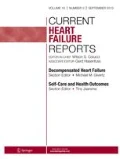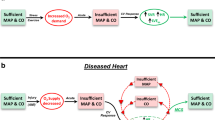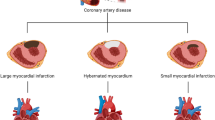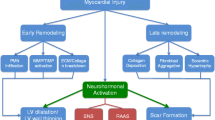Abstract
Myocardial infarction initiates progressive changes in the biology of the myocyte and nonmyocyte components of the myocardium, as well as the geometry of the left ventricle. Despite the use of evidence-based strategies to postmyocardial infarction, heart failure supervenes and is attended by an unacceptably high mortality rate. Given that left ventricular (LV) remodeling may contribute independently to disease progression, several innovative approaches have been designed to attenuate and reverse LV remodeling. This review discusses the emerging role of epicardial restraint devices in the treatment of postmyocardial cardiac remodeling.
Similar content being viewed by others
References and Recommended Reading
Mann DL: Mechanisms and models in heart failure: a combinatorial approach. Circulation 1999, 100:999–1088.
Mann DL, Bristow MR: Mechanisms and models in heart failure: the biomechanical model and beyond. Circulation 2005, 111:2837–2849.
Tan LB, Jalil JE, Pick R, et al.: Cardiac myocyte necrosis induced by angiotensin II. Circ Res 1991, 69:1185–1195.
Mann DL, Kent RL, Parsons B, Cooper G IV: Adrenergic effects on the biology of the adult mammalian cardiocyte. Circulation 1992, 85:790–804.
Bozkurt B, Kribbs S, Clubb FJ Jr, et al.: Pathophysiologically relevant concentrations of tumor necrosis factor-a promote progressive left ventricular dysfunction and remodeling in rats. Circulation 1998, 97:1382–1391.
Cohn JN, Johnson G, Ziesche S, et al.: A comparison of enalapril with hydralazine-isosorbide dinitrate in the treatment of chronic congestive heart failure. N Engl J Med 1991, 325:303–310.
The SOLVD Investigators: Effect of enalapril on survival in patients with reduced left ventricular ejection fractions and congestive heart failure. N Engl J Med 1991, 325:293–302.
The SOLVD Investigators: Effect of enalapril on mortality and the development of heart failure in asymptomatic patients with reduced left ventricular ejection fraction. N Engl J Med 1992, 327:685–691.
Bristow MR, Gilbert EM, Abraham WT, et al.: Carvedilol produces dose-related improvements in left ventricular function and survival in subjects with chronic heart failure. Circulation 1996, 94:2807–2816.
Packer M, Bristow MR, Cohn JN, et al.: The effect of carvedilol on morbidity and mortality in patients with chronic heart failure. N Engl J Med 1996, 334:1350–1355.
Cohn JN: Structural basis for heart failure: ventricular remodeling and its pharmacological inhibition. Circulation 1995, 91:2504–2507.
Douglas PS, Morrow R, Ioli A, Reicheck N: Left ventricular shape, afterload, and survival in idiopathic dilated cardiomyopathy. J Am Coll Cardiol 1989, 13:311–315.
Vasan RS, Larson MG, Benjamin EJ, et al.: Left ventricular dilation and the risk of congestive heart failure in people without myocardial infarction. N Engl J Med 1997, 336:1350–1355.
Hall SA, Cigarroa CG, Marcoux L, et al.: Time course of improvement in left ventricular function, mass and geometry in patients with congestive heart failure treated with beta-adrenergic blockade. J Am Coll Cardiol 1995, 25:1154–1161.
Tsutsui H, Spinale FG, Nagatsu M, et al.: Effects of chronic b-adrenergic blockade on the left ventricular and cardiocyte abnormalities of chronic canine mitral regurgitation. J Clin Invest 1994, 93:2639–2648.
Doughty RN, Whalley GA, Gamble G, et al.: Left ventricular remodeling with carvedilol in patients with congestive heart failure due to ischemic heart disease. J Am Coll Cardiol 1998, 29:1060–1066.
Sabbah HN, Sharov VG, Gupta RC, et al.: Reversal of chronic molecular and cellular abnormalities due to heart failure by passive mechanical ventricular containment. Circ Res 2003, 93:1095–1101.
Linzbach AJ: Heart failure from the point of view of quantitative anatomy. Am J Cardiol 1960, 69:370–382.
Ross J Jr: Afterload mismatch in aortic and mitral valve disease: implications for surgical therapy. J Am Coll Cardiol 1985, 5:811–826.
Ross J Jr: Mechanisms of cardiac contraction: what roles for preload, afterload and inotropic state in heart failure? Eur Heart J 1983, 4(Suppl A):19–28.
Hirota Y, Saito T, Kita Y, et al.: The natural history of dilated cardiomyopathy and pathophysiology of congestive heart failure [in Japanese]. J Cardiogr Suppl 1986, 9:67–76.
Pouleur H, Rousseau MF, van Eyll C, et al.: Cardiac mechanics during development of heart failure. Circulation 1993, 87:IV14–IV20.
Kapadia SR, Oral H, Lee J, et al.: Hemodynamic regulation of tumor necrosis factor-alpha gene and protein expression in adult feline myocardium. Circ Res 1997, 81:187–195.
Sadoshima J, Xu Y, Slayter HS, Izumo S: Autocrine release of angiotensin II mediates stretch-induced hypertrophy of cardiac myocytes in vitro. Cell 1993, 75:977–984.
Ruwhof C, van der Laarse A: Mechanical stress-induced cardiac hypertrophy: mechanisms and signal transduction pathways. Cardiovasc Res 2000, 47:23–37.
Kass DA, Baughman KL, Pak PH, et al.: Reverse remodeling from cardiomyoplasty in human heart failure. External constraint versus active assist. Circulation 1995, 91:2314–2318.
Batista R: Partial left ventricularectomy—the Batista procedure. Euro J Cardiothor Surg 1999, 15(Suppl I):S12–S9.
Dor V, Saab M, Coste P, et al.: Left ventricular aneurysm: a new surgical approach. Thorac Cardiovasc Surg 1989, 37:11–9.
White HD, Norris RM, Brown MA, et al.: Left ventricular end-systolic volume as the major determinant of survival after recovery from myocardial infarction. Circulation 1987, 76:44–51.
Kelley ST, Malekan R, Gorman JH 3rd, et al.: Restraining infarct expansion preserves left ventricular geometry and function after acute anteroapical infarction. Circulation 1999, 99:135–142.
Moainie SL, Guy TS, Gorman JH 3rd, et al.: Infarct restraint attenuates remodeling and reduces chronic ischemic mitral regurgitation after postero-lateral infarction. Ann Thorac Surg 2002, 74:444–449; discussion 449.
Enomoto Y, Gorman JH 3rd, Moainie SL, et al.: Early ventricular restraint after myocardial infarction: extent of the wrap determines the outcome of remodeling. Ann Thorac Surg 2005, 79:881–887; discussion 881–887.
Rastogi S, Mishra S, Gupta RC, Sabbah HN: Reversal of maladaptive gene program in left ventricular myocardium of dogs with heart failure following long-term therapy with the Acorn Cardiac Support Device. Heart Fail Rev 2005, 10:157–163.
Saavedra WF, Tunin RS, Paolocci N, et al.: Reverse remodeling and enhanced adrenergic reserve from passive external support in experimental dilated heart failure. J Am Coll Cardiol 2002, 39:2069–2076.
Gupta RC, Sharov VG, Mishra S, et al.: Chronic therapy with the Acorn Cardiac Support Device (CSD) attenuates cardiomyocyte apoptosis in dogs with heart failure. J Am Coll Cardiol 2001, 37:478A.
Chaudhry PA, Mishima T, Sharov VG, et al.: Passive epicardial containment prevents ventricular remodeling in heart failure. Ann Thorac Surg 2000, 70:1275–1280.
Rastogi S, Gupta RC, Mishra S, et al.: Long-term therapy with the acorn cardiac support device normalizes gene expression of growth factors and gelatinases in dogs with heart failure. J Heart Lung Transplant 2005, 24:1619–1625.
Sabbah HN: Effects of cardiac support device on reverse remodeling: molecular, biochemical, and structural mechanisms. J Card Fail 2004, 10(6 Suppl):S207–S214.
Pilla JJ, Blom AS, Brockman DJ, et al.: Ventricular constraint using the acorn cardiac support device reduces myocardial akinetic area in an ovine model of acute infarction. Circulation 2002, 106(12 Suppl 1):I207–I211.
Blom AS, Mukherjee R, Pilla JJ, et al.: Cardiac support device modifies left ventricular geometry and myocardial structure after myocardial infarction. Circulation 2005, 112:1274–1283.
Cheng A, Nguyen TC, Malinowski M, et al.: Passive ventricular constraint prevents transmural shear strain progression in left ventricle remodeling. Circulation 2006, 114(1 Suppl):I79–I86.
Raman JS, Hata M, Storer M, et al.: The mid-term results of ventricular containment (ACORN WRAP) for end-stage ischemic cardiomyopathy. Ann Thorac Cardiovasc Surg 2001, 7:278–281.
Oz MC, Konertz WF, Kleber FX, et al.: Global surgical experience with the Acorn cardiac support device. J Thorac Cardiovasc Surg 2003, 126:983–991.
Mann DL, Acker MA, Jessup M, et al.: Clinical evaluation of the CorCap Cardiac Support Device in patients with dilated cardiomyopathy. Ann Thorac Surg 2007, 84:1226–1235.
Starling RC, Jessup M, Oh JK, et al.: Sustained benefits of the CorCap Cardiac Support Device on left ventricular remodeling: three year follow-up results from the Acorn clinical trial. Ann Thorac Surg 2007, 84:1236–1242.
Magovern JA, Teekell-Taylor L, Mankad S, et al.: Effect of a flexible ventricular restraint device on cardiac remodeling after acute myocardial infarction. ASAIO J 2006, 52:196–200.
George I, Cheng Y, Yi GH, et al.: Effect of passive cardiac containment on ventricular synchrony and cardiac function in awake dogs. Eur J Cardiothorac Surg 2007, 31:55–64.
Klodell CT Jr, Aranda JM Jr, McGiffin DC, et al.: Worldwide surgical experience with the Paracor HeartNet cardiac restraint device. J Thorac Cardiovasc Surg 2008, 135:188–195.
Fukamachi K, Popovi ZB, Inoue M, et al.: Changes in mitral annular and left ventricular dimensions and left ventricular pressure-volume relations after off-pump treatment of mitral regurgitation with the Coapsys device. Eur J Cardiothorac Surg 2004, 25:352–357.
Inoue M, McCarthy PM, Popovi ZB, et al.: The Coapsys device to treat functional mitral regurgitation: in vivo long-term canine study. J Thorac Cardiovasc Surg 2004, 127:1068–1076.
Mishra YK, Mittal S, Jaguri P, Trehan N: Coapsys mitral annuloplasty for chronic functional ischemic mitral regurgitation: 1-year results. Ann Thorac Surg 2006, 81:42–46.
Grossi EA, Saunders PC, Woo YJ, et al.: Intraoperative effects of the Coapsys annuloplasty system in a randomized evaluation (RESTOR-MV) of functional ischemic mitral regurgitation. Ann Thorac Surg 2005, 80:1706–1711.
Kashem A, Santamore WP, Hassan S, et al.: CardioClasp: a new passive device to reshape cardiac enlargement. ASAIO J 2002, 48:253–259.
Ghanta RK, Rangaraj A, Umakanthan R, et al.: Adjustable, physiological ventricular restraint improves left ventricular mechanics and reduces dilatation in an ovine model of chronic heart failure. Circulation 2007, 115:1201–1210.
Author information
Authors and Affiliations
Corresponding author
Rights and permissions
About this article
Cite this article
Topkara, V.K., Kondareddy, S. & Mann, D.L. Modulation of left ventricular dilation remodeling with epicardial restraint devices in postmyocardial infarction heart failure. Curr Heart Fail Rep 6, 229–235 (2009). https://doi.org/10.1007/s11897-009-0032-6
Published:
Issue Date:
DOI: https://doi.org/10.1007/s11897-009-0032-6




